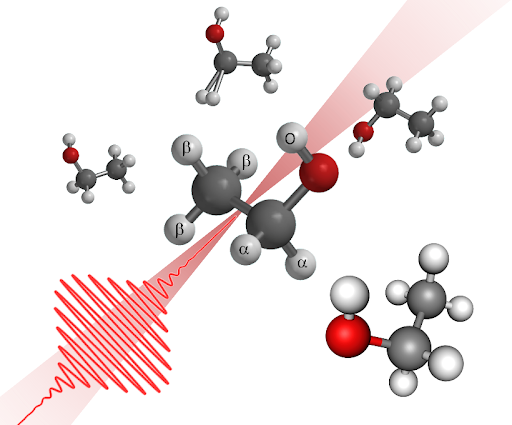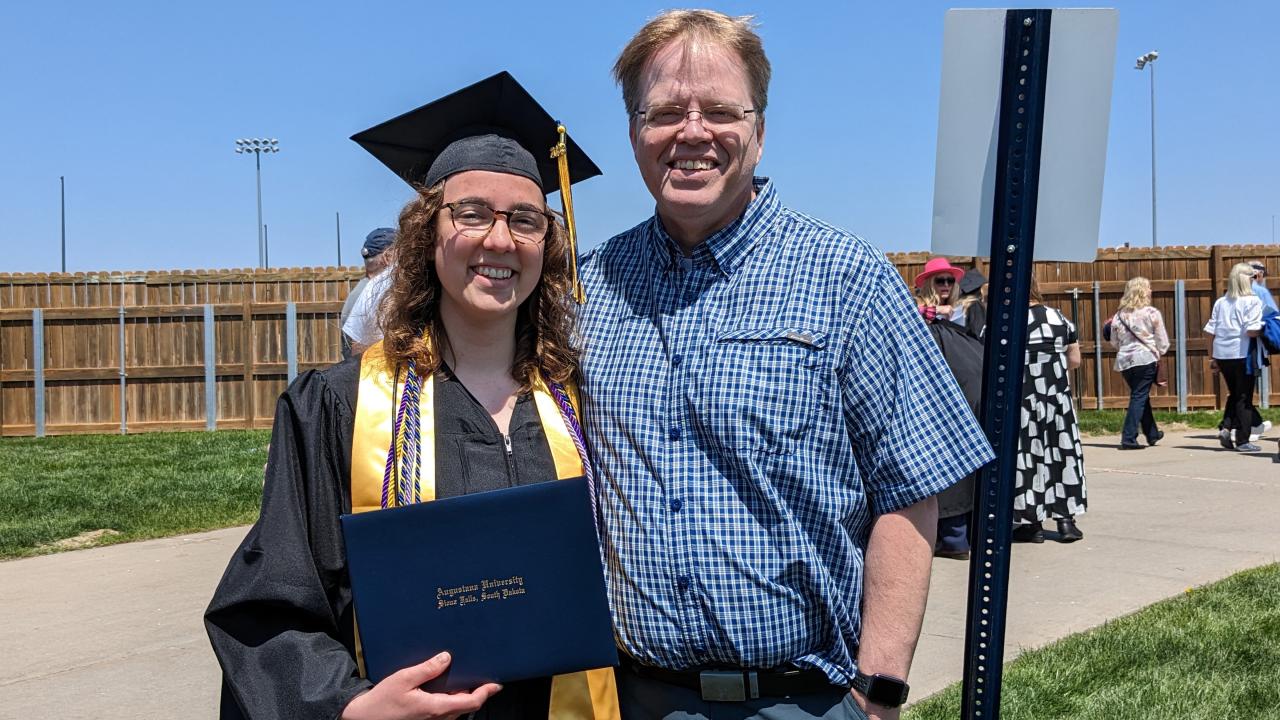Augustana University alumna Eleanor Weckwerth ‘23 and Professor of Physics Dr. Eric Wells were part of a research team that was published in “Nature Communications” — a multidisciplinary, peer-reviewed journal with 85 million annual downloads.
“It's extremely cool to (have done) work at this level as an undergrad,” Weckwerth said. “I'm excited the article is published, and I'm super glad I got to learn from such a great group of people.”
Weckwerth and Wells joined researchers from Kansas State (KSU) and Michigan State (MSU) Universities to publish “Initial state characterization of hydrogen migration following strong-field double-ionization of ethanol.” The research behind the article began in 2018 using ultrafast laser pulses at the J.R. Macdonald Laboratory at KSU.
 “Ethanol has three hydrogens on one end, one on the other end and two in the middle,” Wells explained. “The first question was, ‘Would the two in the middle move together and do things collectively?’ They answered that question, but the follow-up question was, ‘Can we figure out what all the hydrogens are doing at the same time?’
“Ethanol has three hydrogens on one end, one on the other end and two in the middle,” Wells explained. “The first question was, ‘Would the two in the middle move together and do things collectively?’ They answered that question, but the follow-up question was, ‘Can we figure out what all the hydrogens are doing at the same time?’
“This hydrogen migration problem, as it's called, is a foundational problem in the field — if you excite or remove electrons, how does that energy couple into making the atoms move?” Wells continued. “It's a fundamental question. If you can figure out how all of them are moving, that's what we were after — to try to understand all the different ways it could go and how likely one way was instead of another.”
The end game, Wells said, is the ability to use lasers to manipulate molecules exactly as wanted and needed. This, he said, could have potential implications on pharmaceutical and technological industries.
KSU and MSU scientists performed the experiment, and Weckwerth — who triple majored in physics, mathematics and chemistry (ACS) at Augustana — led the data analysis.
“There were seven different experiments because we used seven kinds of ethanol,” Wells said. “For each of those experiments, you can imagine all the permutations of the ways ethanol can break into two or three pieces. So, she had to identify the rate at which all of those processes occurred for each of those seven experiments.
“Then she had to write down the system of equations that govern those, and one of our systems had 55 equations in it. So, she had to solve 55 equations simultaneously,” Wells continued, adding that those equations didn’t include the unknowns for which Weckwerth also had to solve.
Weckwerth, who is pursuing a graduate degree in physics from Stanford University in California, performed data analysis on the project for more than two years while she was an Augustana student.
“When I started this project, I viewed it as a fun puzzle to try to solve, but as I dug more into the data and began to understand more of the underlying physics, I really began to appreciate the value of the questions we were studying — plus, it was still a fun puzzle,” Weckwerth said. “That's what made me want to continue doing similar research in grad school.”
For Weckwerth, although the work was intense, it was an opportunity that not many undergraduate students get, especially at smaller institutions like Augustana. Many of the published articles in “Nature Communications” come from doctoral universities (R1s) or researchers in national laboratories, said Wells.
“As the project progressed, I was able to use what I was learning outside of the research in my physics classes about how to ask the right questions and present information clearly,” said Weckwerth. “Dr. Wells helped me with every step of the process, constantly answering my questions about everything from the technical details of the analysis to the physics behind the processes we were studying.”
Wells credits these opportunities for students to Augustana’s primary partnership with KSU that began in 2003 when he arrived at Augustana. The universities have joint grants, including ones that have paid for new lasers at KSU. Wells has spent sabbaticals at the Kansas campus, AU students have pursued graduate school there — including Dr. Bethany Jochim ‘11, one of the paper’s other authors — and more than 30 students have done research there as AU undergraduates.
“Because our partners know we do good work, they are eager to collaborate with us, and this turns into outstanding student opportunities,” said Dr. Nathan Grau, Augustana professor of physics. “Eleanor had a leadership role on an internationally-recognized research project because of the relationships our faculty maintain.”
Augustana’s portion of the research was funded by the National Science Foundation (NSF). KSU’s J.R. Macdonald Laboratory and MSU’s portion of the research was supported by the U.S. Department of Energy’s Offices of Science and Basic Energy Sciences, as well as its Chemical Sciences, Geosciences and Biosciences (CSGB) Division.
To learn more about the physics major at Augustana, visit augie.edu/physics.
